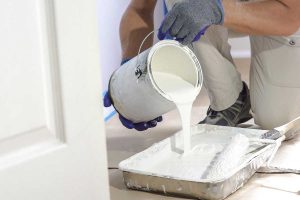Considering interior doors are the first thing you see before entering a room, it doesn’t hurt if you refresh their paint when they’re showing wear or tear. Repainting them may be a small change, but a flawless finish can make a significant impact on the overall look of your home.
Whether you want to match the color of your doors with your walls for a minimal look or add a contrasting hue for a pop of color, below are rules you should keep in mind when painting your interior doors.
What is the correct paint for doors?
To help you figure out what paint you should use for your interior door, you have first to determine what kind of paint was used previously. You can do this by using the alcohol test by rubbing a piece of cotton or cloth that’s dampened with alcohol on a spot on your door.
If paint transfers to the cotton or cloth, it means the previous paint used was water or latex-based, but if nothing comes off, it’s oil-based. If you’re dealing with oil-based paint and want to apply a coat of latex-based formula, it’s best to sand and apply primer first to ensure the new coat adheres better to the surface.
If you’re wondering what type of paint you should use, interior acrylic latex paint should look great on your door. The finish should be up to your choice, but avoid matte or flat paint finishes since their rough textures are prone to scuffing and trapping dirt.
Should you paint the door in place or remove it?
Painting pros recommend you remove your interior door from the frame when painting because it’s easier to apply long brush strokes and cover panels when it’s laid flat. It’s also less awkward to repair and sand your door if it’s removed from the frame since you won’t be fighting with gravity.
You’ll also be able to place your door in a well-ventilated space when drying so the paint fumes won’t circulate around your house. But if you’re working with limited space, you can make an exception of painting your door while it’s attached to prevent limiting your mobility around your house.

How many coats of paint do interior doors need?
Similar to wall trims, your door should have 2 coats of paint to get an even finish. If you’re working with an unpainted door, apply one coat of primer first to provide a smoother surface and add an extra layer of protection against moisture. But if the door has been previously painted, you can apply 2 new coats of paint directly.
Should you use a brush or roller for painting interior doors?
You should use a paintbrush and roller for painting your interior doors. The brush is great for painting the sides, inset panels, and intricate moldings since it can get into small crevices. Using a 1 or 2-inch brush should be suitable for this portion of the process.
Once you’re done with the smaller details, you can use a paint roller to cover the rest of the surfaces of the door more efficiently. A 3 or 5-mm nap roller should work great for the job.
When should you paint the interior doors?
If you’re doing a total room makeover, follow the old rule of painting from top to bottom. You should paint the ceiling first, followed by the walls and trims. The door frame and door should be the last step since it only takes a smaller area and a steady hand to finish the job.
You don’t have to worry about getting paint drips on the door frame and doors since you can easily cover them later. If you want to make sure the interior door doesn’t get any paint splatters when you’re working, you can detach it from the frame during paint prep and store it outside of the room.
How do you paint interior doors like a pro?
Now that you know about the basics of painting your interior doors, you can follow this step-by-step guide on how to paint it like a pro:
- Remove the door from the frame, making sure to detach the hardware, door knob, and locks.
- Sand the door with 120-grit sandpaper to remove old paint and create a smoother surface for the new paint coat to adhere to.
- If your door has cracks or holes that need fixing, fill them with putty or wood filler and allow them to dry completely.
- Don’t forget to sand the repaired areas to flatten the surface. Then, wipe away any dust with a damp cloth so they don’t mix with the paint.
- If you’re using primer, apply one coat and allow it to dry.
- Once the primer is completely dry, apply 2 coats of your chosen color. Use a brush to paint the inset panels to cover them precisely. Allow each coat of paint to dry in between.
- When the paint is dry, reattach your door to its frame. Then, reinstall the doorknob, hardware, and locks.
Can you paint interior doors without sanding?
Professional painters highly recommend sanding the interior door before painting to remove old and chipping paint. It also smooths out any rough textures noticeable when the paint dries. But most importantly, it provides a smoother surface so the primer and paint adheres better and lasts longer.
You won’t need to put in a lot of elbow grease since a light sanding is enough to even out the texture of your door.
The only way you might probably get away with not sanding is if your door is still in pristine condition. You won’t also need to sand if you’re adding a new layer of latex-based paint on top of old coats.
Need help with painting your house?
If you need help painting your house, Soho Painters is the best painting contractor in New York. They have a team of experienced painters with the best materials, tools, and training to ensure quality results. They also offer wallpapering, apartment, and commercial painting services to cover all your needs. For questions or inquiries, contact them now and book a free estimate.





